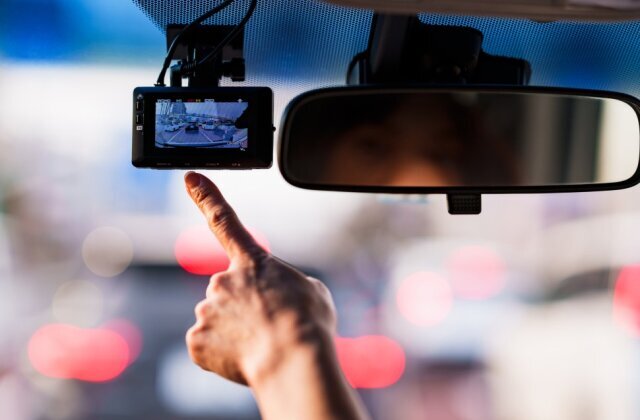Dash cams, small video cameras attached to a vehicle’s dashboard or windshield, are gaining popularity amongst drivers. Their ability to record traffic incidents provides valuable evidence during accidents, insurance disputes, and even unexpected events. However, if you’re considering getting a dash cam in Wisconsin, it’s important to understand the state’s specific regulations for their legal use.
Dash cams are compact cameras offering drivers added security and peace of mind on the road. They continuously record footage of your travels, and this can be invaluable in the following situations:
- Traffic Accidents: Dash cams offer unbiased proof of fault in collisions, protecting you from false accusations.
- Insurance Claims: Footage can streamline the claims process and help prevent insurance fraud.
- Unexpected Road Events: Dash cams can capture everything from hit-and-runs to unusual occurrences.
- Driving Behavior Monitoring: Some dash cams can be used to improve driving habits for personal use or fleet management.
While these benefits are enticing, Wisconsin, like many states, has specific rules about dash cam use to uphold road safety and privacy laws.
Legal Considerations
- Placement Regulations
Wisconsin laws stipulate that dash cams can only be mounted behind the rearview mirror. This helps minimize obstruction of the driver’s view. Additionally, the camera must not block the area cleaned by the vehicle’s windshield wipers.
- Obstruction of View Restrictions
Wisconsin laws take driver visibility very seriously. It’s illegal to have anything between the driver and the windshield that could obstruct the view. While dash cams are generally permitted, their placement must comply fully with these regulations.
- Audio Recording and Privacy
Wisconsin is a “one-party consent” state regarding audio recording. This means you can legally record conversations you are a part of without informing the other person. However, if the dash cam captures conversations of others without their knowledge, legal complications could arise. It’s advisable to consider dash cam models that allow you to easily disable audio recording when needed.
Dash Cams in the Courtroom
- Admissibility
Dash cam footage can be incredibly useful in legal proceedings. Usually, it is considered admissible evidence in Wisconsin courts, provided it follows certain guidelines:
* **Relevance:** Footage must directly relate to the case at hand.
* **Authenticity:** The source and chain of custody of the footage need to be established.
* **Compliance with Laws:** Dash cam footage obtained in violation of Wisconsin regulations may be inadmissible.
- Examples in Practice
Dash cam use in legal settings has grown, and Wisconsin is no exception. Examples of uses include:
* **Contesting Citations:** Footage can help dispute traffic violations.
* **Proving Negligence:** In car accidents, footage helps establish the actions of other drivers involved.
* **Insurance Disputes:** Dash cams can accelerate claims and deter fraudulent claims.
Choosing the Right Dash Cam
With so many options, here’s what to keep in mind:
- Image Resolution: Higher resolution (1080p or 4K) ensures sharper details and better evidence in low-light conditions.
- Storage Capacity: Choose a dash cam with a large enough memory card or cloud storage if you frequently record long trips.
- Additional Features
- GPS tracking: Records location data along with footage.
- Night Vision: Improves image quality in poor lighting.
- Parking Mode: Continues recording even when the car is off.
- Collision Detection: Automatically saves footage of severe impacts.
- Recommendations
Here are a few well-regarded dash cams across budgets:
- Budget-friendly: Consider the Vantrue N2 Pro or the Rove R2-4K
- Advanced Features: Options like the Garmin Dash Cam 67W or the Nextbase 622GW offer wider feature sets.
Installation Best Practices
- Professional Installation: While some dash cams are DIY-friendly, professional installation ensures compliance with Wisconsin law. Installers have the expertise for proper placement and discreet wiring.
- DIY Tips: If you opt for DIY installation, follow these guidelines: * Accurately position the camera behind the rearview mirror. * Ensure no part of the dash cam or its wiring blocks the driver’s view of the road. * Securely fasten the camera to prevent it from becoming a projectile in a collision. * Manage wiring neatly to avoid dangling cables that could obstruct movement or controls.
Conclusion
Dash cams, when used responsibly and legally, offer Wisconsin drivers a powerful tool for protection on the road. By understanding the state’s specific regulations you’re ensuring that any footage you might need to rely on is both legal and useful.
Here’s a recap of the most important points:
- Mount your dash cam exclusively behind the rearview mirror.
- Make sure it doesn’t impede your view of the road or the wiper-cleaned areas.
- Be aware of audio recording privacy considerations.
- Select a dash cam suitable for your needs and budget.
- Consider professional installation for the most compliant setup.
Investing in a dash cam that suits your requirements and following these guidelines empowers you with extra security and peace of mind while driving in Wisconsin.
Sources
To ensure the information in this article is accurate and up-to-date, here are the sources used:
- Wisconsin State Legislature – Chapter 347: Equipment of Vehicles: https://docs.legis.wisconsin.gov/statutes/statutes/347
- BlackboxMyCar – Dash Cam Laws by State: https://www.blackboxmycar.com/pages/are-dash-cams-legal-in-my-area-dash-cam-laws-in-every-us-state
- Eisenberg Law Offices – Wisconsin Dash Cam Footage: https://eisenberglaw.org/firm-overview/articles/dash-cam-footage-in-wisconsin-car-accident-cases/
Important Disclaimer This article provides general information on Wisconsin’s dash cam regulations. It does not constitute official legal advice. Consult an attorney for specific legal guidance on dash cam use or issues relating to its use in any proceeding. Laws and regulations are subject to change, so it’s prudent to verify the most up-to-date information before making decisions based on the contents of this article.



